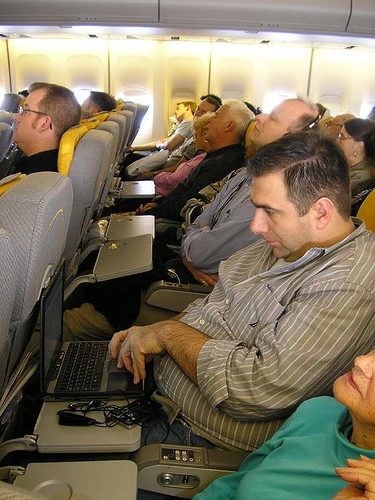Would you use in-flight Wi-Fi? (Would you pay for it?)


Are there certain flights you would consider doing so (such as intercontinental) versus those you wouldn't (domestic)?
A neat article by Joe Sharkey in the New York Times today details the trend of airlines rushing head over heels to offer Wi-Fi Internet connections in domestic aircraft cabins at the expense of -- you guessed it -- your hard-earned cash and, more notably, space.
Sharkey describes a recent AirTran Airways Wi-Fi demonstration flight from Baltimore-Washington up and down the Eastern Seaboard:
The Internet worked just fine. The problem was actually being able to use it efficiently. My laptop was wedged onto a tray table in the cramped space of a coach seat. I had to slide down in my seat just to read the screen.
“I have the same experience,” said Jack W. Blumenstein, the chief executive of Aircell, the company that is providing nearly all of the Wi-Fi installations so far for domestic carriers. “The laptop’s at an angle or it’s propped up almost on my nose.”
“Or I’m typing like this,” Mr. Blumenstein said from his own coach seat on the flight. He slouched down, raised both hands and wriggled his fingers like someone scratching on a window.
The low-cost AirTran announced last week that it would be installing Aircell's Gogo Inflight Internet service on its fleet by midsummer, making it the first domestic carrier to offer Wi-Fi on its entire fleet.
Delta Air Lines, American Airlines, United, Virgin America and Air Canada are all installing in-flight Wi-Fi systems, all but Delta using Aircell's Gogo system, which depends on land-based cellular towers and can't be used on overseas flights.
The problem, as previously mentioned, is twofold: First, that the in-flight experience is hardly accomodating for passengers toting laptops, including a lack of electrical outlets, physical issues such as those described above and price.
AirTran, for example, is charging $9.95 for flights under three hours and $12.95 for those over three hours. For smartphones, the price is $7.95 regardless of flight duration. Is there enough demand for that kind of price?
Would you pay $10 for Wi-Fi from Chicago to New York? How about $13 for New York to San Francisco?
It's a tough question. Sure, $10 or $13 isn't much on the face of it, but if you're being nickel-and-dimed all the way down the runway -- pillow? Five dollars. Headphones? Five dollars. Movie? Five dollars. Peanuts? Two dollars. Stiff drink to make you forget the experience? Ten dollars -- you might just deem Wi-Fi not worth the headaches.
This is not just a question of price, of course. This is also a question of our human inclination to activity on domestic flights. Whether for business or pleasure, if you can get important work done elsewhere -- home, the airport, your hotel -- would you prefer to get a little shut-eye or read your Kindle instead of cracking open the ultimate distraction: the web?
According to the Times article, the Gogo service costs an average of about $100,000 a plane to install, and "Usage has exceeded expectations," an Aircell spokesperson said. And I'm sure most tech-inclined people agree with me that Internet connectivity should at least be available on flights.
But it makes me wonder if I'd rather just read a book on the flight to Tampa than risk more eye and back strain peering at my netbook or my BlackBerry for two hours, for that price. Decisions like this, of course, impact the viability of this business model.
What would you do?